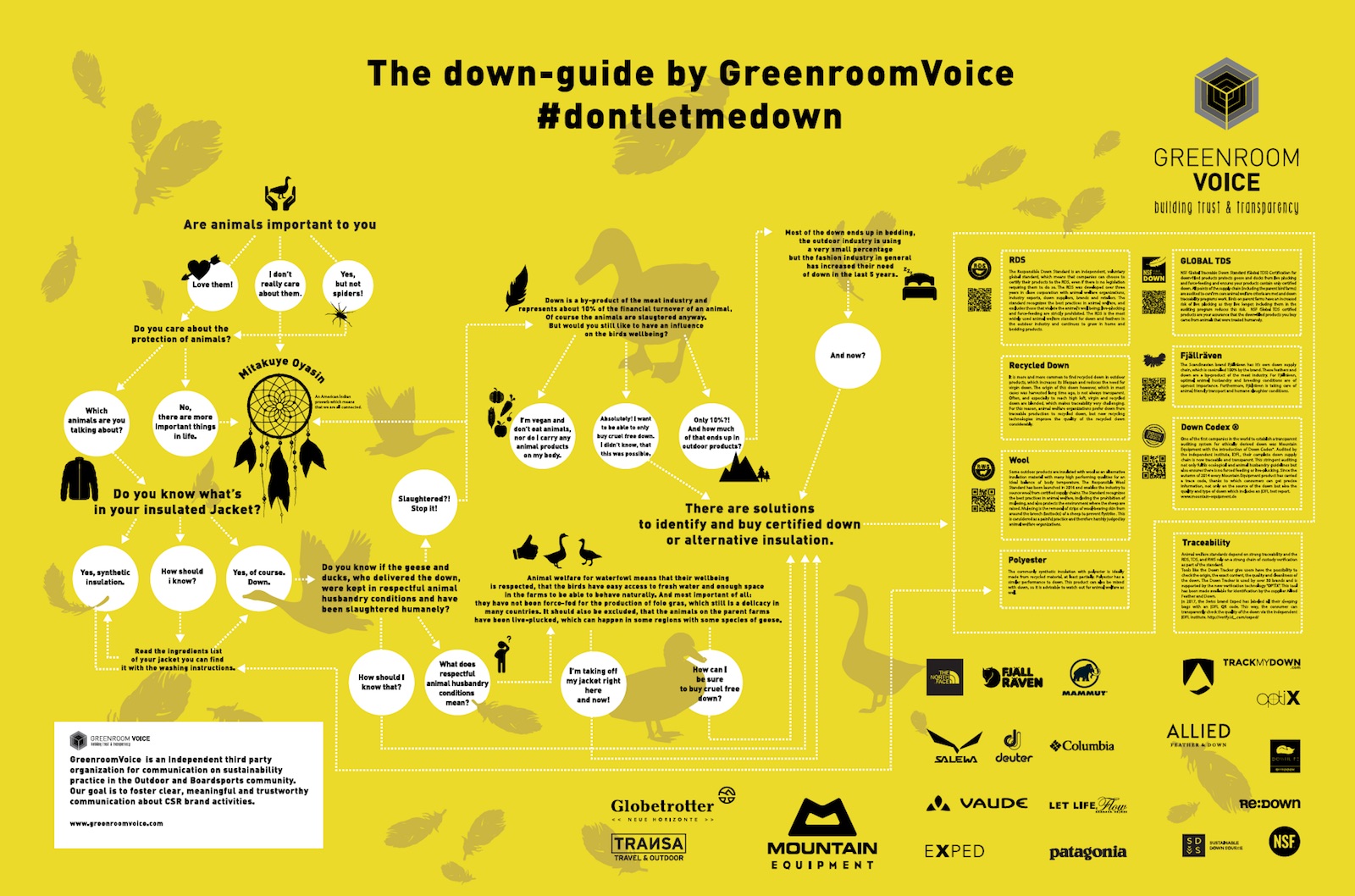We probably love animals as much as you do. We care for our cats and dogs, but what about ducks? Do we need to get them through some aweful process just to get some insulation in our winter jackets? Not really! There are alternatives and solutions that are easy to understand but most people are not aware of them. This is what this poster is all about. We want to make people aware of what they are wearing and allow them to make the right choice.
Buying a down jacket or a down sleeping bag has similar consequences than buying organic or non-organic food. Animals are involved and are at risk to be harmed, if we are not careful. Several NGOs have raised concerns about the issue of animal welfare around down products in outdoor equipment, and now, many consumers are more aware of the importance of animal husbandry conditions in the products they purchase. The outdoor industry has a unique role to play and quite a few brands are trying to make positive changes.
Targeting this sensible market was a strategic move by the NGO’s, which lead to action, and more and more outdoor brands are looking into the issues of traceability and animal welfare.
Even though the outdoor industry is using less than 1% of the global down supply, brands like Patagonia and The North Face have considerably helped to develop global animal welfare standards.
Some individual approaches had already existed for years. Fjällräven for example, have their down supply chain 100% controlled. Mountain Equipment audits according to their own stringent standard with an independent evaluation body, IDFL. These individual efforts are now being joined by global solutions for certified product. And it is great to see that many brands are prepared to support this movement by using certified down. Some of those brands are present on the GRV Down Guide.
Meat? Down is and will always be a by-product of the meat industry. These birds are raised in the first place for their meat! Down accounts for less than 10% of the financial turnover of the animals. For this reason, the origin of the down has been of less interest for most, while the production practices still holds some considerable risks for the birds. And if brands want to make sure, that none of their down comes from mistreated animals, they must take traceability seriously.
Therefore, animal welfare standards rely on a strong chain of custody verification as part of the standard.
But first of all, we need to look at the reality of waterfowl meat production and its traditions. In some countries, the production of Fois-Gras, which entails forced feeding, is considered a traditional delicacy and not banned by the governments.
Herein lies the biggest risk of harm to the animals.
Down is supplied by two different types of farms: The collector-based farms, which are mostly small family businesses selling the meat for local or personal consumption.
By best estimates in the eastern European countries, 80% of down and feathers are coming from the collector-based farms. These farmers often can’t read nor write and are located wide-spread all over the country. It is very difficult and cost intensive to audit them strategically. But the risk of harm the the birds is relatively lower, than in industrial farms, which may practices force-feeding or life-plucking, practices generally regarded as painful and cruel to the animals.
On a family farm birds of all ages are raised together, some to lay the eggs and most are bred to be killed early for their meat and their down. Larger, industrial farms are separated into the parent and the breeding farms. The Parent farms only raise the birds to lay eggs. These birds live for up to four years. With some species of geese, which naturally lose their down on a regular basis to re-grow it again, and therefore, the risk of live plucking is higher in these parent farms. This practice, often called molt harvesting, is where the down is rubbed off the chest of the living bird to harvest more down during its lifetime. Since this can be executed quite brutally, the birds can suffer considerably. It only works with certain species of goose, so the percentage of live plucking is quite low in the overall picture. But never the less, a risk is always present and this is why the Global Traceable Down Standard requires parent farm audits in the advanced level.
The eggs from parent farms are then transported to the breeding farms. In China, which is the biggest producer of duck meat and duck down, the eggs are distributed by the government, which makes traceability nearly impossible. Then again, duck is rarely live plucked.
At the breeding farms, the birds only live a few weeks or months before being slaughtered. The biggest risk at this stage is forced feeding for the production of fois gras, next to generally unsuitable animal husbandry conditions.
Animal welfare standards, like the Responsible Down Standard and the Global TDS are making sure the birds have access to water, enough space to behave naturally, and that they are not forced-fed. After slaughter, the down is immediately identified and tracked using the guidelines of the Content Claim Standard to be identifiable along its journey throughout the processes of washing, sterilizing and sorting.
Of course there are some alternatives to virgin down. Recent developments in recycling technologies have considerably improved the quality of recycled down. Suppliers like RE:Down and Allied Feather and Down offer these products in their portfolios.
By only sourcing from certain regions, Allied Feather and Down even tries to eliminate the risk of violation of animal husbandry practices, which could have harmed the birds that provided the original virgin down harvested long time ago. One of the biggest risks in recycled down is that it is virtually untraceable and often mixed with virgin down to increase loft and quality.
As an alternative to down, some brands like Ortovox, Mover or Let it Flow, insulate their products with wool. Wool has some unmatched proprieties in regards to the body temperature balance. When it is cold, wool keeps you warm and when it is too hot, wool keeps you cool. It might be a little bit heavier than down, but this will likely make little difference for anyone who is not a professional alpinist. Of course it is also an animal product and it makes sense to watch out for the recently launched Responsible Wool Standard to protect the animals well being and the environment.
Polyester is also a very common insulation material. PrimaLoft® is one of the biggest suppliers in the market and offers products that are partially recycled or mixed with certified virgin down. This synthetic insulation is likely the most appealing for the vegan community. Polyester can be engineered in such a way that it has most of the properties of natural down. It dries a bit faster and as mentioned before, it can be recycled.
Of course, polyester is not natural fiber and has to be disposed of professionally at some point.
This is a great example, on how complex the thought of sustainability can be and how people tend to judge very differently based on their own priorities. Some will exclude animal products from their lives completely, to prevent any potential harm to the animals. Others are worried about the global charge of plastic, which is threatening our oceans and environments and ultimately also harm animals by being introduced into the food chain.
No matter what kind of material is being used, cheap production in great volumes with the goal to maximise profits, leads in almost all cases to harm for the environment, animals and ultimately humans.
But well-managed supplies with guiding values that respect humans, animals, eco design, sustain biodiversity, resource efficiency and emission management are less troubling.
It really is up to everyone to be informed about important materials and their potential impacts. Everyone has the power to direct consumption towards a sensible use of materials to fulfil their needs.
Therefore, it is so importance to look for and recognize products that are in tune with one’s personal values. We need a knowledge base to decide what to buy and when.
This is the reason why we designed the GRV Down Guide.
View the down-guide by GreenroomVoice

